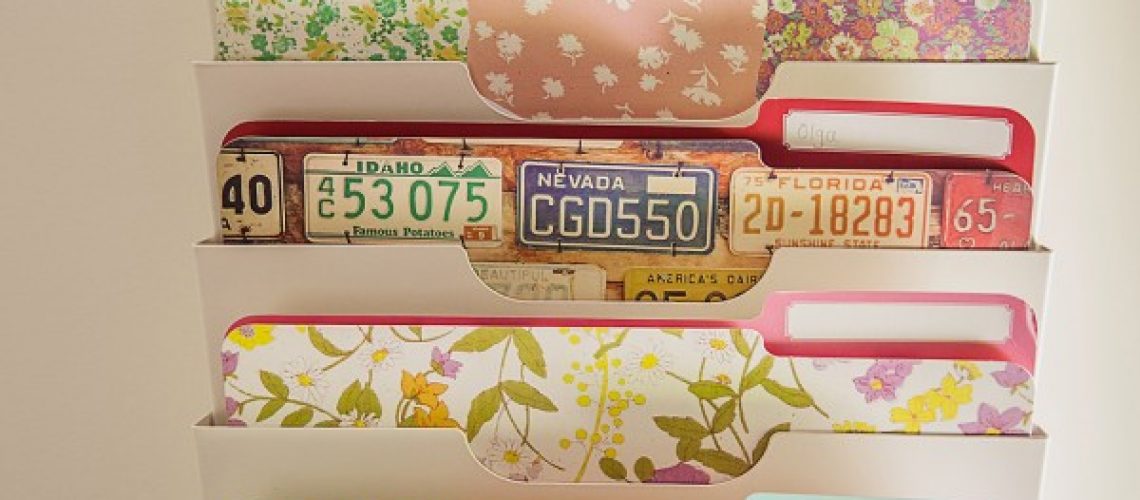Do you need some filing rules? If you have a filing system set up but find that it fills up quickly and needs to be culled you just might. After deciding what you really need to keep, there are ways to maintain your filing system without having to do a yearly clear out. Here are a few filing rules to get you started.
One-in-one-out rule
Let’s use bank statements as an example. You’ve decided you need to keep bank statements, and you prefer a printed version. Generally, these come monthly, so to keep it manageable, decide in advance how many months or years you need to keep. If it’s a well-established folder, cull what you don’t need. Arrange it in date order with the newest one at the front of the folder. Every time a new one arrives, add it to the front. At the same time, remove the oldest one from the back of the pile and shred it.
If you’ve just created the folder and it’s empty, all of this still applies (except for the toss the oldest one out bit). Decide how many months or years you want to keep. Write on a sticky note the month and year you’ll start tossing statements. That will prompt you to toss them at that time. Alternatively, you can add a note in your phone calendar to remind you that it’s now time to start shredding the old ones.
This tip can be applied to most filing folders.
Store the newest or most recent file at the front of your pile
This filing rule is to make culling easier in future sessions. Storing recent items at the front of the folder means you can take the back section of the folder and toss it. Simple and easy.
Spend time naming your files – it’s important!
Always spend time deciding how you’ll label the file. It needs to be something you’ll remember. Otherwise, you end up with multiple folders storing the same things. Worse still, you need to find something and you can’t, even though you remember filing it.
Things to consider when naming your folders
Start by asking yourself, “What will I be referring to this for in the future?”’ This will help you know what to file it under. Then think about if there is an ‘umbrella’ category. I’ll give a few examples of this.
- You have a car insurance document. When you ask the above questions you think ‘I’ll pull it out to make an insurance claim’. The umbrella category for you may either be ‘Car’ (which files all things car-related, with subfolders like ‘Insurance’) or it may be the umbrella category of ‘Insurance’ (with subfolders like ‘car’, ‘house’, ‘health’).
- A more unusual example might be an article on archaeology, you’d like to keep. When you answer the questions you might think, “I’m keeping it because I may refer to it for my work”, or “I want to write an article on this sometime”, or “I find it interesting”. In this instance, your umbrella folder name might be ‘Resources’, ‘Article Ideas’ or ‘Interesting Topics’. The subcategories in this may be Archaeology. It might need to be more specific if, for example, all your work is all related to archaeology. In that case such a generalist folder name will not be sufficient and the file will be lost.
Be sure not to get too specific because you need to remember what you filed it under. What’s the general gist of the article? How would you summarise it? What would you be referencing this document for?
Is it still not getting filed? Ask yourself some deeper questions!
If you’re working through your filing and some papers never seem to get filed, then it’s time to sit with it a little longer and ask yourself some more questions. Don’t let them stall your progress. Ask yourself, “Why am I keeping this?”. This will really help you decide what to do with it and create filing rules for them.
Forget justifying if you should or not keep it. If you’re agonising over it, chances are you’ve decided to keep it already. You’re just not clear on the why. So if the above question doesn’t quite get the answer you’re after, ask it again, “But why?”.
Let me give you an example from a session with a client. We’ll call her Jo. We’ came across an article on psychology, on hoarding disorder. I asked, “Why are you keeping this?”. The conversation went something like this:
Jo: “I don’t know. It’s interesting and I’d like to keep it.”
Me: “Sure, but what are you going to be referring back to it for?”
Jo: “Hmmm, well I like to write blogs on various topics and this one interests me.”
Me: “OK, so you’d like to write and reference this article in your future blog post?”
Jo: “Yes, or it’ll give me some ideas to write my article”.
Me: “Great. Do you keep a lot of these sorts of things?”
Jo: “Yes, on lots of different topics”.
Me: “Ok, so we could file it under an umbrella category of Articles or Blog Inspiration and then a subcategory of Hoarding Disorder. What do you think?”
Jo: “Hmmm I generally only write on psychology-related things though so maybe Psychology with a subcategory of Hoarding“.
Keep probing deeper and you’ll get to the bottom of it
To give you a head start, here are a few reasons as to why you might be keeping papers:
- It’s a memory and you want to capture the memory somehow (e.g. journaling)
- You want to write about it for a book
- You want to journal about it and consolidate what you’ve learnt
- You’ll use it for craft
- You have to keep it for tax purposes
- You’d like to refer back to it/or a strong feeling about having to keep it (like bank statements or bills)
- It’s a reminder of something you want to do
- It’s interesting or makes you laugh (so what can you do with it so you can access it regularly instead of it sitting around in the drawer?)
Filing rules for paper related memories
So what do you do with paper related memories or journals and notebooks? Well, you can:
- File it
- Put it with your memory box items
- Make a note about it on an app or the PC for things you could do with it, and then store it in a box until you do that project. Within this list you may have a summary of projects. That is, a task for each project or topic. (Project 1 – read through work diaries and journal about what I’ve learnt. Project 2 – Write a chapter or a blog post on ‘being single’.)
- Pin it to a notice board
- Frame it
- Add it to the craft box
- Photograph it
- Scan it and file it onto your PC
Hopefully, these filing rules and tips will help you get your filing in order, and keep you from having to do big culls every year or so. What’s your paperwork tip? Please share in the WellSorted Facebook Group!







